Wednesday, 12 September 2018
Tuesday, 14 August 2018
Beginners Property Secrets Training
Rob Moore is a property millionaire and has built a team around him to provide unbeatable training on how to get into the property market as well as non-property related strategies for creating financial freedom.
This video was shot a few years back now and Rob no longer runs the training courses himself but has instead trained a few people up and the good news from this is that this particular course is now held more regularly than it was previously as is the MSOPI (Multiple Streams of Property Income) 3 day course that Rob also refers to in the video, but this one isn't really for beginners.
If you are even just a little curious about investing in property and finding out if this could be a wealth creation strategy for you then this full day course in Peterborough, North Cambridgeshire would be absolutely ideal. You might be surprised to hear that it is possible to start building your property portfolio with little or no money.
The RRP for this course is £990 but I can arrange FREE tickets for both you and a guest too.
Just fill in your details below and someone will call you with event dates and to arrange your booking. You won't regret it!
Friday, 10 August 2018
Wednesday, 8 August 2018
Tuesday, 7 August 2018
Monday, 6 August 2018
Sunday, 5 August 2018
Saturday, 4 August 2018
Friday, 3 August 2018
How To Sell Anything To Anyone Anytime - Sell Me This Pen
One of many comments on this video. "I was expecting a lame, cringy, cliche kind of approach in this video but instead, I've learnt a great lesson in marketing, or in making a sale pitch. He showed me that emotions overwhelms logic."
Thursday, 2 August 2018
Wednesday, 1 August 2018
Tuesday, 31 July 2018
Monday, 30 July 2018
The Do's and Don'ts of Email Subject Lines
An effective email subject lines is the key to increase open rates and potential click through rates. No matter whether you are sending an official mail, monthly news letter or a daily digest; effective subject lines will compel your subscribers to open your mail.
Even though subject lines are very important in email marketing but still it is one of the major obstacles that needs to be overcome. Depending on what it includes, the subscriber will decide whether to open mail or not. Also there is no secret to writing an email subject line that guarantee you an improved open rate and click through.
So there are few tricks and tips that will help to increase the open rates and other things to avoid. Let’s have a look over with these Do’s and Don’ts to get an idea of writing an effective subject line.
The Parameters You Must Include:
- Keep It Simple and Specific
Whenever people read your subject lines, it should be simple and specific about your message and why it’s relevant to them. Lengthy and irrelevant subject lines may cause frustration for your recipients and lead them to ignore or delete your mail. According to analysis, subject lines that had between 28 to 39 characters had the highest open rates.
- Use the Recipient Name or Location
Add a personal touch to your subject line by including recipient name or location. Personalized subject line makes your subscriber more likely to open your mail. In many surveys it has been proved that personalized promotional mailings have 29% higher unique open rates and 41% higher unique click rates than non-personalized mailings.
- Phrase Subject Line as a Question
One of the best ways to grab your subscriber attention is to ask a question in your subject line. A recent study by Mailchimp has found that subject line phrased as questions perform better than subject line that were phrased as normal statements.
- Make Sure to Address Your Subscribers
Don’t confuse your subscribers when your mail shows up in their inbox. Include your address - means your brand name or product name in brackets at the beginning of the subject line.
- Include a Call to Action
It’s very important to inform your subscribers what their next step should be. If not, they will just read subject line without understanding further action is required from their part.
The Points You Must Avoid:
- Usage of Special Characters in Subject line
This trick may increase the click rates, but it occasionally hit into the spam folders. Another recent trend is using tons of emoticons in subject line, this may increase open rates but it do not affects much on click rates.
- Being Too Mysterious
Of course, you want to intrigue your subscribers, but don’t be vague in a subject line. Give a clear picture of why you’re sending mail to them before they open your message. Too much vagueness can lead to ambiguity and ultimately that mail will be dumped to spam folder.
- Include Numbers
Including numbers in the subject line often increase engagement levels and interest. This can also put your email in danger of getting lost in the profusion of “special offers” floating around in cyberspace.
- Asking for help
Nowadays people have become cautious of this tactic because so many email marketers used it in a scammy way.
- Being an obvious sales pitch
In these days, being an obvious sales pitch like “Don’t miss this opportunity” will not only appear like white noise to your subscriber, there will be also more chance to reach the spam folders.
Email marketing is all about the information which you want to convey to your customers. So follow these do's and don'ts while writing an effective subject line which will indirectly reflects on open rates and click through rates.
Source: Titty William
Even though subject lines are very important in email marketing but still it is one of the major obstacles that needs to be overcome. Depending on what it includes, the subscriber will decide whether to open mail or not. Also there is no secret to writing an email subject line that guarantee you an improved open rate and click through.
So there are few tricks and tips that will help to increase the open rates and other things to avoid. Let’s have a look over with these Do’s and Don’ts to get an idea of writing an effective subject line.
The Parameters You Must Include:
- Keep It Simple and Specific
Whenever people read your subject lines, it should be simple and specific about your message and why it’s relevant to them. Lengthy and irrelevant subject lines may cause frustration for your recipients and lead them to ignore or delete your mail. According to analysis, subject lines that had between 28 to 39 characters had the highest open rates.
- Use the Recipient Name or Location
Add a personal touch to your subject line by including recipient name or location. Personalized subject line makes your subscriber more likely to open your mail. In many surveys it has been proved that personalized promotional mailings have 29% higher unique open rates and 41% higher unique click rates than non-personalized mailings.
- Phrase Subject Line as a Question
One of the best ways to grab your subscriber attention is to ask a question in your subject line. A recent study by Mailchimp has found that subject line phrased as questions perform better than subject line that were phrased as normal statements.
- Make Sure to Address Your Subscribers
Don’t confuse your subscribers when your mail shows up in their inbox. Include your address - means your brand name or product name in brackets at the beginning of the subject line.
- Include a Call to Action
It’s very important to inform your subscribers what their next step should be. If not, they will just read subject line without understanding further action is required from their part.
The Points You Must Avoid:
- Usage of Special Characters in Subject line
This trick may increase the click rates, but it occasionally hit into the spam folders. Another recent trend is using tons of emoticons in subject line, this may increase open rates but it do not affects much on click rates.
- Being Too Mysterious
Of course, you want to intrigue your subscribers, but don’t be vague in a subject line. Give a clear picture of why you’re sending mail to them before they open your message. Too much vagueness can lead to ambiguity and ultimately that mail will be dumped to spam folder.
- Include Numbers
Including numbers in the subject line often increase engagement levels and interest. This can also put your email in danger of getting lost in the profusion of “special offers” floating around in cyberspace.
- Asking for help
Nowadays people have become cautious of this tactic because so many email marketers used it in a scammy way.
- Being an obvious sales pitch
In these days, being an obvious sales pitch like “Don’t miss this opportunity” will not only appear like white noise to your subscriber, there will be also more chance to reach the spam folders.
Email marketing is all about the information which you want to convey to your customers. So follow these do's and don'ts while writing an effective subject line which will indirectly reflects on open rates and click through rates.
Source: Titty William
Saturday, 28 July 2018
Friday, 27 July 2018
Thursday, 26 July 2018
Wednesday, 25 July 2018
Tuesday, 24 July 2018
Monday, 23 July 2018
CPA VS. CPL: What Is The Difference?
In the world of online marketing, there's a bunch of acronyms thrown around that are often confusing to new marketers. It's important to know what these acronyms stand for and what they mean for your business.
What is CPL? CPL stands for Cost-Per-Lead. When you are determining your marketing budget, you may consider doing CPL advertising. This means you are paying only for leads that are delivered to you.
CPL advertising may be less targeted but is still a great way to go. Typically, CPL advertising can run anywhere from $1.00 per lead for loosely targeted leads to upwards of $100.00 per lead for highly targeted, "buyer" leads.
A "buyer" lead is a lead that has already purchased a product in the same or a similar niche as the product or offer you are selling. While $100 may seem like a hefty price tag, it may actually be a great deal depending on your CLV (oh no…another acronym!).
What is CLV? CLV stands for customer lifetime value and is actually the most important number you need to know in your business. the CLV will drive all of your other business decisions and will help you understand what is a reasonable marketing budget for your business.
To calculate the LV of your customer base, take the total revenue you've generated from your sales and divide it by the number of customers you've acquired. For example, if you have generated $58,000 from 40 customers, then the LV per customer would be: $1450.00.
Understanding your CLV will help you to know exactly what it will take to reach your goals. If your business goal is to achieve $1,000,000 in sales and your CLV is around $1,000 then you'd know you would need a minimum of 1,000 customers to achieve that goal.
Then you can set about planning and strategizing how to get there.
How can you tell if the CPL is good for your offer? It just takes a little math. For example, if you get a CPL of $8.00.00. If the Lifetime Value (LV) of your customer is $100.00, then spending $10.00 to get that lead would be great because you are 10X your investment.
What is CPA? CPA is cost-per-acquisition. This is different from CPL because with CPA you are actually paying for a closed sale or a specific action. This is a great way to advertise a product because you are paying for the action you have determined. It may be a sale, a lead or click. (In those cases you would also apply CPL and/or CPC).
CPA is often disclosed by affiliate offers so that the affiliate marketer will know the average cost-per-acquisition when they are marketing a product. This helps the marketer to adjust their marketing/campaign budget so that it is profitable.
For example, if an affiliate knows that the CPA of an offer is around $45.00 and the commission on each product is $100.00, they know that their profit will be around $55.00 after marketing costs.
What is a CPA Network?
A CPA network is a network of advertisers that will pay affiliates for a specific action. For example, ClickSure is a CPA network. Companies and advertisers will load their products into Clickbank and the affiliate marketer will then drive traffic to the various offers.
When a specific action is achieved, such as a sale, the affiliate marketer is then paid for that action.
Another example of a CPA network is Commission Junction. Commission Junction has thousands of advertisers, including some well known names like GoDaddy, Constant Contact, Discover Card, and more. The advertisers are broken up into categories.
As a website owner and/or affiliate marketer, you can choose to advertise any of these companies and/or their products. Some companies will you per click delivered, some for leads delivered and some for sales. They have decided on their CPA and you are paid for delivering the specific action.
As a business owner, you can choose to advertise on CPA networks. You then pay only for the specific action delivered.
As an affiliate, you can choose from thousands of offers that match your marketing niche, the niche of your list, and the niche of your website.
Source: Shannon J Lavenia
What is CPL? CPL stands for Cost-Per-Lead. When you are determining your marketing budget, you may consider doing CPL advertising. This means you are paying only for leads that are delivered to you.
CPL advertising may be less targeted but is still a great way to go. Typically, CPL advertising can run anywhere from $1.00 per lead for loosely targeted leads to upwards of $100.00 per lead for highly targeted, "buyer" leads.
A "buyer" lead is a lead that has already purchased a product in the same or a similar niche as the product or offer you are selling. While $100 may seem like a hefty price tag, it may actually be a great deal depending on your CLV (oh no…another acronym!).
What is CLV? CLV stands for customer lifetime value and is actually the most important number you need to know in your business. the CLV will drive all of your other business decisions and will help you understand what is a reasonable marketing budget for your business.
To calculate the LV of your customer base, take the total revenue you've generated from your sales and divide it by the number of customers you've acquired. For example, if you have generated $58,000 from 40 customers, then the LV per customer would be: $1450.00.
Understanding your CLV will help you to know exactly what it will take to reach your goals. If your business goal is to achieve $1,000,000 in sales and your CLV is around $1,000 then you'd know you would need a minimum of 1,000 customers to achieve that goal.
Then you can set about planning and strategizing how to get there.
How can you tell if the CPL is good for your offer? It just takes a little math. For example, if you get a CPL of $8.00.00. If the Lifetime Value (LV) of your customer is $100.00, then spending $10.00 to get that lead would be great because you are 10X your investment.
What is CPA? CPA is cost-per-acquisition. This is different from CPL because with CPA you are actually paying for a closed sale or a specific action. This is a great way to advertise a product because you are paying for the action you have determined. It may be a sale, a lead or click. (In those cases you would also apply CPL and/or CPC).
CPA is often disclosed by affiliate offers so that the affiliate marketer will know the average cost-per-acquisition when they are marketing a product. This helps the marketer to adjust their marketing/campaign budget so that it is profitable.
For example, if an affiliate knows that the CPA of an offer is around $45.00 and the commission on each product is $100.00, they know that their profit will be around $55.00 after marketing costs.
What is a CPA Network?
A CPA network is a network of advertisers that will pay affiliates for a specific action. For example, ClickSure is a CPA network. Companies and advertisers will load their products into Clickbank and the affiliate marketer will then drive traffic to the various offers.
When a specific action is achieved, such as a sale, the affiliate marketer is then paid for that action.
Another example of a CPA network is Commission Junction. Commission Junction has thousands of advertisers, including some well known names like GoDaddy, Constant Contact, Discover Card, and more. The advertisers are broken up into categories.
As a website owner and/or affiliate marketer, you can choose to advertise any of these companies and/or their products. Some companies will you per click delivered, some for leads delivered and some for sales. They have decided on their CPA and you are paid for delivering the specific action.
As a business owner, you can choose to advertise on CPA networks. You then pay only for the specific action delivered.
As an affiliate, you can choose from thousands of offers that match your marketing niche, the niche of your list, and the niche of your website.
Source: Shannon J Lavenia
Sunday, 22 July 2018
Saturday, 21 July 2018
Friday, 20 July 2018
Thursday, 19 July 2018
Wednesday, 18 July 2018
How to Design Images for Facebook Ads that Get More Conversions
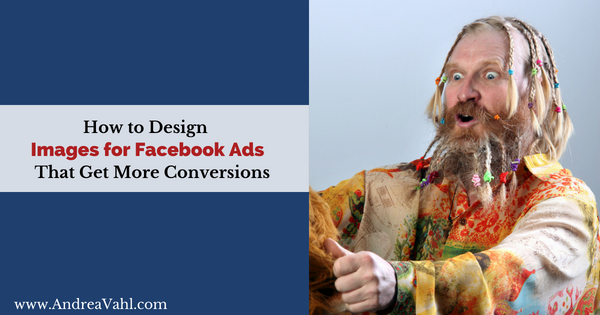
Are you wondering how to design images for Facebook Ads that really work? In this article I’ll dive into how you can create noticeable images that gets more conversions (or clicks, or whatever your goal).
Tip #1 – Start with the right size
In general the best size for most single image types of Facebook ads is 1200 x 628 pixels or something with proportions 1:1.91. If you have an image that is sized differently, the image will get cut off.
Event ads and Like ads (under the Engagement objective) are sized at 1200 x 444 pixels.
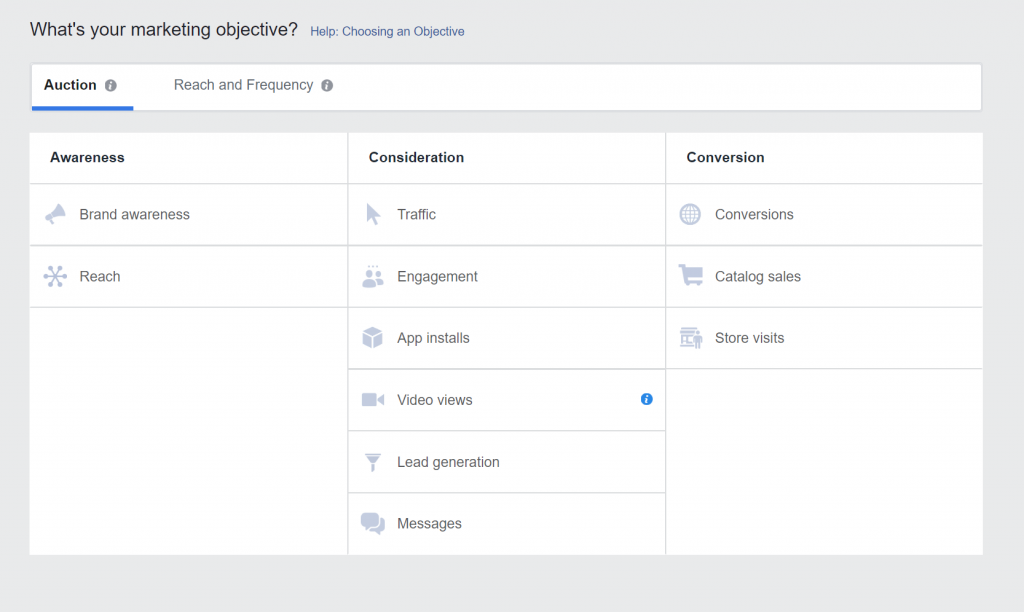
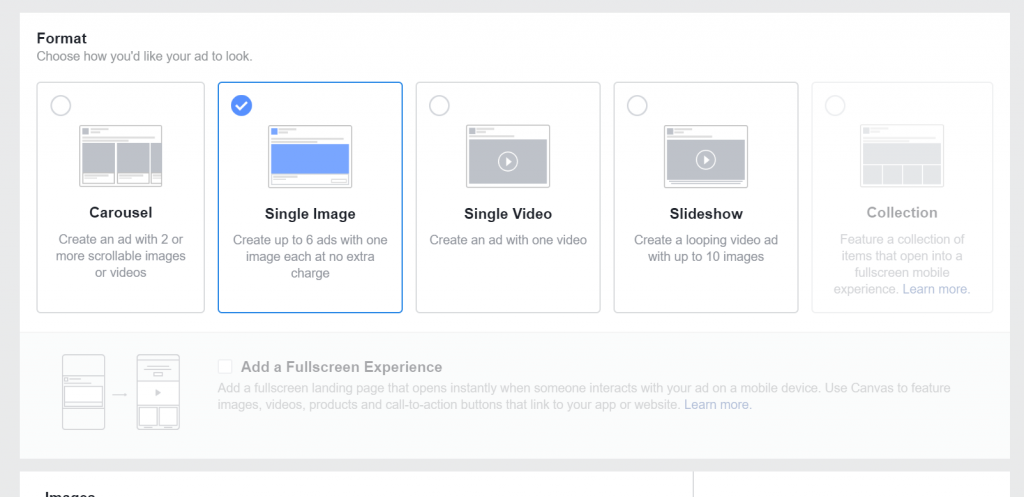
Once you choose the image, make sure you use the other Text areas in your ad.
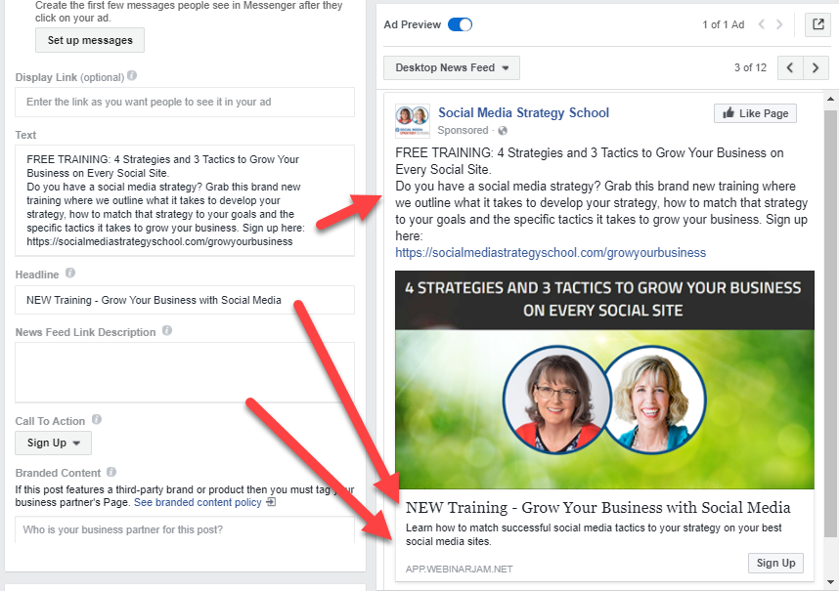
For Carousel Ads or Instagram Ads, use a square 1080 x 1080 pixel image.
Canvas ads and Collection Ads are more advanced and can images that are sized differently. You can have longer images and some of the Canvas and Collection options do need to be square.
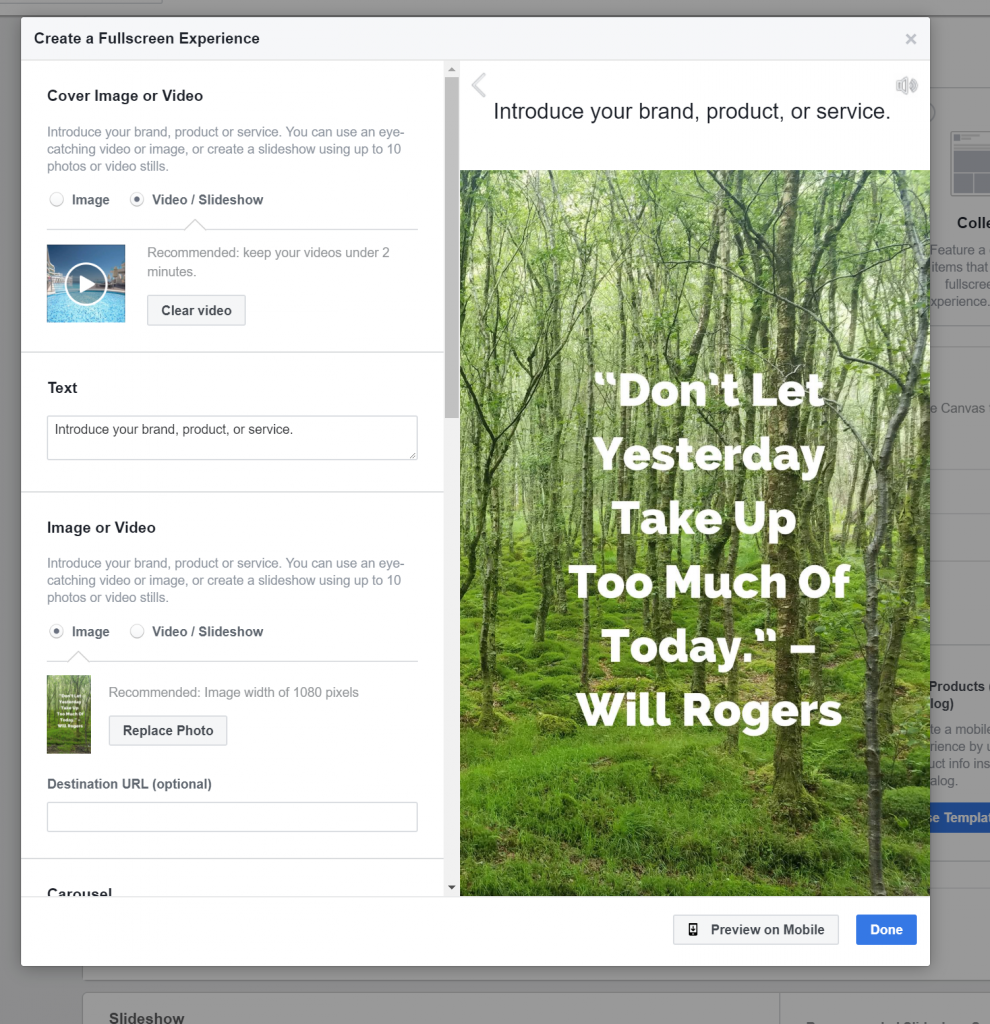
I use Canva to create the right sizes of images for Facebook Ads but there are other good tools out there like PicMonkey and RelayThat.
I use the Facebook ad dimensions for the featured image in my blog posts so that when I share it, it’s already set up to look good on Facebook and go into an ad.
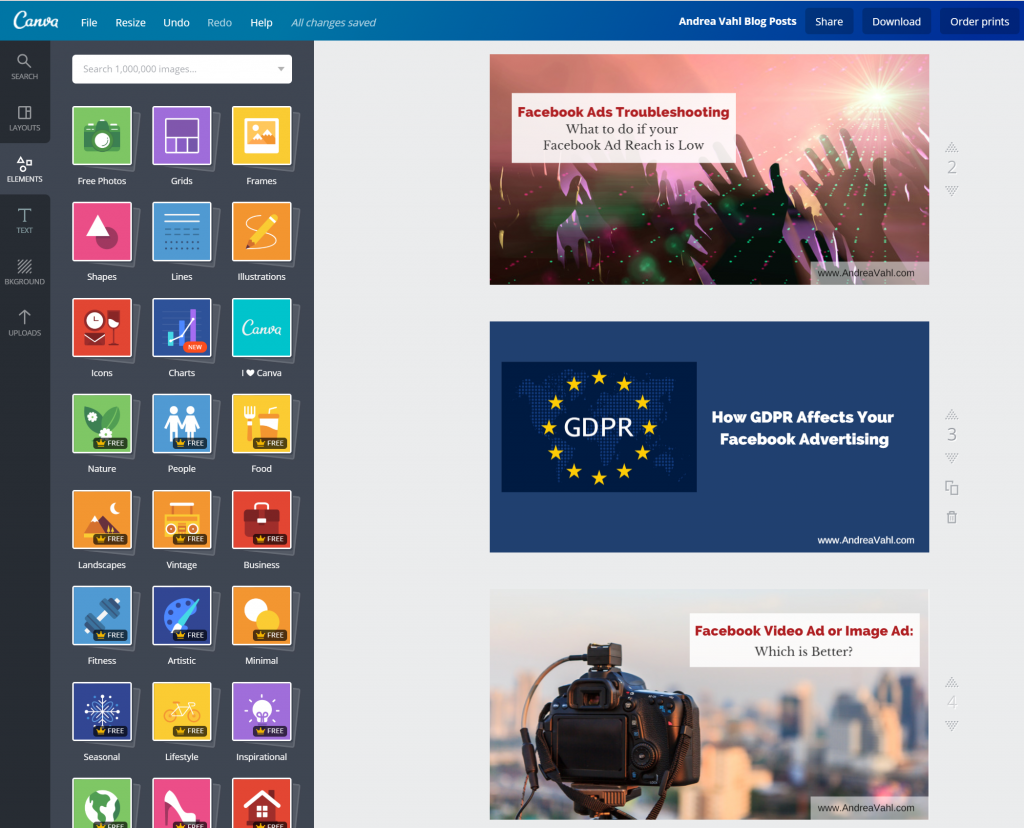
Tip #2 – Not too much text
Even though the 20% text rule is “gone”, Facebook will still stop ads that have too much text in them.
You will get a warning that your ad may not run, but in general, I just see how it goes and place the ad anyway.
It is better to start with lower text images if you can.
You can use the Facebook Text Overlay tool to see what it says about the image before you place the ad.
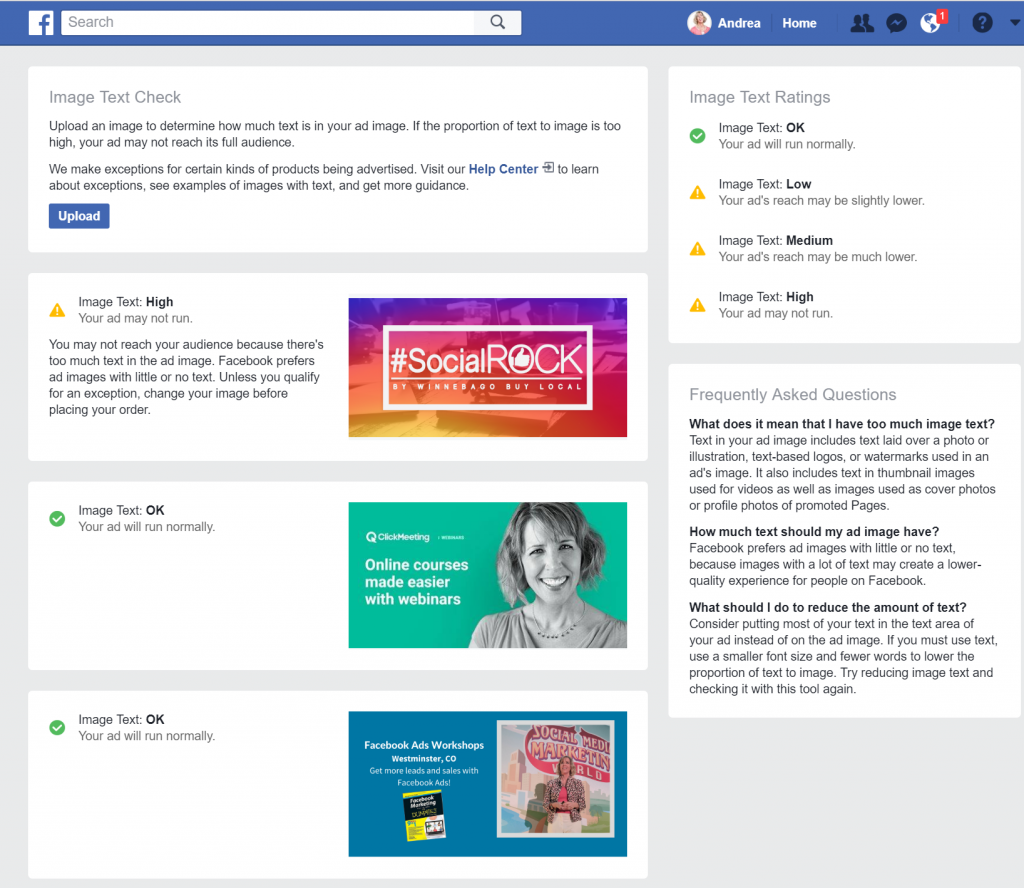
Text on book images or products or logos are not supposed to “count” in the text guidelines but sometimes your ad will get disapproved anyway. You can always appeal.
If you do have text, make sure the font is clear and the text is readable on desktop and mobile (if you are advertising on both).
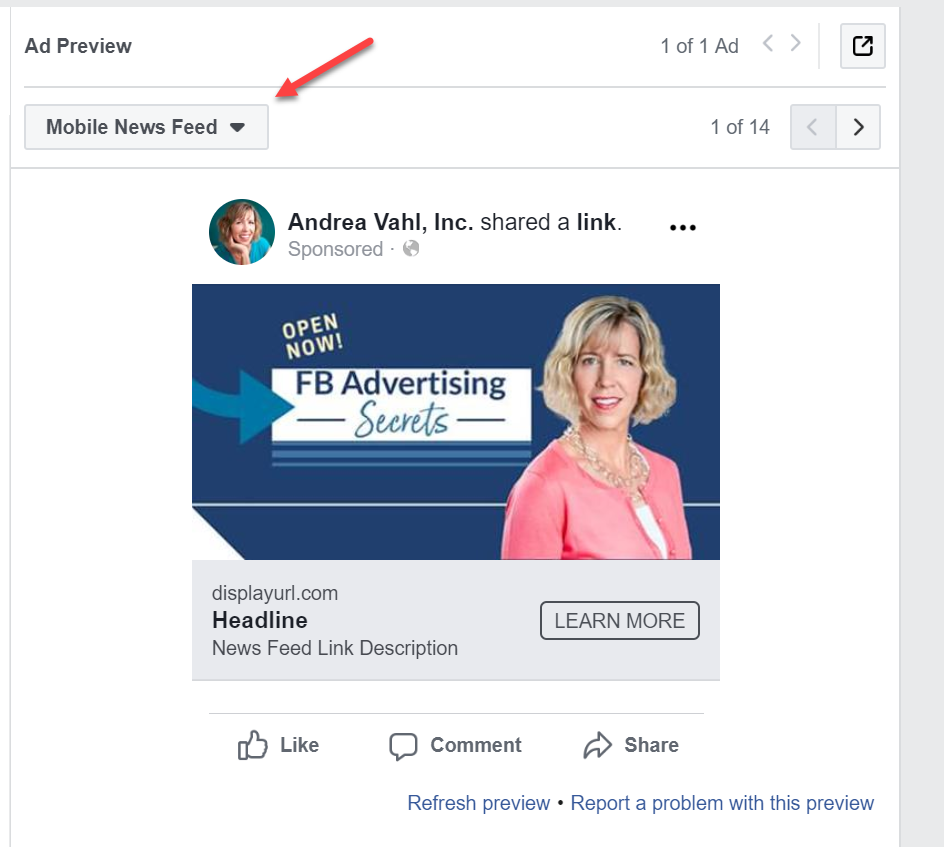
Or you can use images with no text and just an eye-catching image.
Tip #3 – Use an image that catches the eye
Whether you have some text in the ad, or no text, the base image you choose is critical.
In general, images with people in them do better than objects, but that isn’t always true.
Also, I try to avoid overly “cliché stock images”.
We are competing with friends and family posts so it can be hard to grab attention with your ad.
Think about what makes you stop and click on an ad. Is it the promise? Is it funny or unusual?
With Facebook Ads, the Goal is to Stop the Scroll
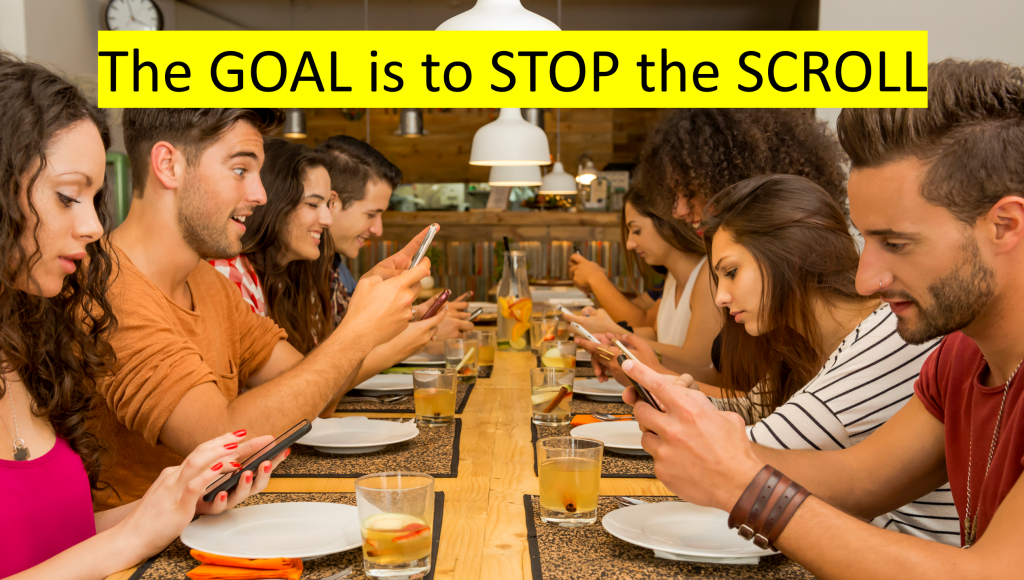
Some good places for images are:
- Pixabay
- Pexels
- Depositphotos (not free)
Tip #4 – Test different images
Split testing your Facebook ads is the key to really finding out which image works best.
I often guess wrong. That’s why you must test at least 2 different images when you run an ad.

In this example, the top image got 5x cheaper conversions than the bottom ad – all targeting and the text were the same in each ad!
We didn’t run the bottom ad as long obviously because I didn’t want to waste my money (and I probably should have stopped it earlier actually).
Good images are one of the biggest factors in the success of a Facebook ad and testing what works for you can put you on the path to better results!
Tuesday, 17 July 2018
Monday, 16 July 2018
4 Ways To Boost Your Website Engagement And Conversion
People often ask me why, as a business coach, I specialize in working with creative professionals. The answer is, I love to see talented people fulfilled in their work, as busy as they want to be, and be compensated really well for what they do.
But what I learned from my 15+ years as an agent for independent copywriters, art directors and fashion illustrators is that talent and taste aren't enough. If you're going to land those coveted projects, you need to stand out, connect and be ready to close the deal.If the mere mention of closing the deal makes your feel queasy, take a deep breath! I'm going to share 4 easy-to-implement ways in which your website can help you do that. Ready?
1) Incorporate language into your website
Even if your work is 100% visual, adding language gives your work context, communicates your mission and helps clients get to know, like and trust you. Bonus, if your text is keyword-rich SEO rating will benefit from a nice boost.
Not a writer? No problem. Here are some ways you can easily incorporate language:
Testimonials:
Nothing boosts your credibility more than having other people say how awesome you are. Sprinkle testimonials throughout your site and be sure one is on your home page.
A positioning statement:
This can be a short paragraph, or 2-liner. Your goal is to state what you do, who you do it for and what they get out of the process. For example, mine is: "I help freelancers and creative entrepreneurs define what makes them unique, create a clear marketing message and strategy, and get more clients".
Your story:
I'd much rather read someone's story than another boring bio. That said, your story must have a purpose, structure and flow. Rambling childhood memories are not client attractive!
2) Present work that resonates with the client you want to attract
I recently did a website VIP planning and strategy day with a photo artist and one of her challenges editing and presenting her work. We started out by selecting only the images that she really loved and felt represented her vision. Sounds simple, right? But when factors such as what colors people in certain regions like and what you images you have in inventory (and therefore, are motivated to move) get involved, your vision can quickly become clouded. Next we printed out the image select and laid them out, left to right, on the floor (an old agent trick) to see how they flowed. We immediately saw that the edit would be much more impactful if we reversed the order. Funnily enough the opening image was one she had initially felt ambiguous about, but now made sense within context of the edit and flow.
Be objective, look at your work with fresh eyes and edit, edit, edit. If you can't do it alone, recruit an objective and constructive partner to help you.
3) Drive traffic to your site
One of the biggest mistakes entrepreneurs and freelancers make is subscribing to the belief that if they build it, people will come. It's a nice idea, but unfortunately it doesn't work that way. Prospective clients need several points of contact before they're ready to buy, so you need to be consistently on their radar. I've tried every method from cold-calls to promotional mailings, and the best way I know is to share high-quality, high-value content with your prospects - no strings attached. Whether it's a newsletter, blog, social media or give-away on your website, building and nurturing your list is invaluable.
4) Get clients to take action
One of the first questions I ask my coaching clients is "what do you want people to do when they get to your website?" Answers range from a blank expression to "enjoy the work". If you don't know what you want people to do, how are theygoing to know what to do?
Here are a few things you might want them to do, along with suggestions of how to get them to do it:
Join your mailing list:
Create something helpful/educational/gorgeous that they can download once they subscribe. Make sure that the offering really is of value and is related to the services you offer. For example, I offer a free 5-step guide to building a thriving creative business.
Call you:
Have a call to action that clearly communicates what you want them to do and what they will get e.g. "for a free 20-minute consultation call me" or " call me to discuss your next campaign". Make sure that you include a link that takes them to your contact page or your on-line calendar.
Check out your services:
You might create a 'Work With Me' button or link that takes them directly to your services page. Whatever your call to action is make it really easy for them to follow through on it.
5) Bonus tip: Have a submission form on your contact page.
If your contact page features just your email address and phone number, your visitors now have to find a pen, write it down, open their email, type it in... You get the point: the more obstacles there are between them and you, the less likely they are to make contact. Make it really easy!
Source: Justine Clay
But what I learned from my 15+ years as an agent for independent copywriters, art directors and fashion illustrators is that talent and taste aren't enough. If you're going to land those coveted projects, you need to stand out, connect and be ready to close the deal.If the mere mention of closing the deal makes your feel queasy, take a deep breath! I'm going to share 4 easy-to-implement ways in which your website can help you do that. Ready?
1) Incorporate language into your website
Even if your work is 100% visual, adding language gives your work context, communicates your mission and helps clients get to know, like and trust you. Bonus, if your text is keyword-rich SEO rating will benefit from a nice boost.
Not a writer? No problem. Here are some ways you can easily incorporate language:
Testimonials:
Nothing boosts your credibility more than having other people say how awesome you are. Sprinkle testimonials throughout your site and be sure one is on your home page.
A positioning statement:
This can be a short paragraph, or 2-liner. Your goal is to state what you do, who you do it for and what they get out of the process. For example, mine is: "I help freelancers and creative entrepreneurs define what makes them unique, create a clear marketing message and strategy, and get more clients".
Your story:
I'd much rather read someone's story than another boring bio. That said, your story must have a purpose, structure and flow. Rambling childhood memories are not client attractive!
2) Present work that resonates with the client you want to attract
I recently did a website VIP planning and strategy day with a photo artist and one of her challenges editing and presenting her work. We started out by selecting only the images that she really loved and felt represented her vision. Sounds simple, right? But when factors such as what colors people in certain regions like and what you images you have in inventory (and therefore, are motivated to move) get involved, your vision can quickly become clouded. Next we printed out the image select and laid them out, left to right, on the floor (an old agent trick) to see how they flowed. We immediately saw that the edit would be much more impactful if we reversed the order. Funnily enough the opening image was one she had initially felt ambiguous about, but now made sense within context of the edit and flow.
Be objective, look at your work with fresh eyes and edit, edit, edit. If you can't do it alone, recruit an objective and constructive partner to help you.
3) Drive traffic to your site
One of the biggest mistakes entrepreneurs and freelancers make is subscribing to the belief that if they build it, people will come. It's a nice idea, but unfortunately it doesn't work that way. Prospective clients need several points of contact before they're ready to buy, so you need to be consistently on their radar. I've tried every method from cold-calls to promotional mailings, and the best way I know is to share high-quality, high-value content with your prospects - no strings attached. Whether it's a newsletter, blog, social media or give-away on your website, building and nurturing your list is invaluable.
4) Get clients to take action
One of the first questions I ask my coaching clients is "what do you want people to do when they get to your website?" Answers range from a blank expression to "enjoy the work". If you don't know what you want people to do, how are theygoing to know what to do?
Here are a few things you might want them to do, along with suggestions of how to get them to do it:
Join your mailing list:
Create something helpful/educational/gorgeous that they can download once they subscribe. Make sure that the offering really is of value and is related to the services you offer. For example, I offer a free 5-step guide to building a thriving creative business.
Call you:
Have a call to action that clearly communicates what you want them to do and what they will get e.g. "for a free 20-minute consultation call me" or " call me to discuss your next campaign". Make sure that you include a link that takes them to your contact page or your on-line calendar.
Check out your services:
You might create a 'Work With Me' button or link that takes them directly to your services page. Whatever your call to action is make it really easy for them to follow through on it.
5) Bonus tip: Have a submission form on your contact page.
If your contact page features just your email address and phone number, your visitors now have to find a pen, write it down, open their email, type it in... You get the point: the more obstacles there are between them and you, the less likely they are to make contact. Make it really easy!
Source: Justine Clay
Sunday, 15 July 2018
Saturday, 14 July 2018
Friday, 13 July 2018
How to Earn Money on Instagram as an Affiliate Marketer

Facebook marketing has its merits, but the most recent social media marketing hype for affiliates is now on Instagram.
The app has over 700 million monthly active users, and a staggering 400 million daily users, making it a massive social media portal with massive potential for marketing opportunities.
As an affiliate marketer, your key objectives are to drive traffic to your site by effectively using as many communication channels as possible. Considering the millions of potential customers that you can tap into on Instagram, there are a sea of sales opportunities waiting to happen once you join.
Instagram’s app engagement ranks above Tumblr, Twitter, Snapchat, Pinterest as well as LinkedIn and in addition to being able to gain recognition among relevant niches and market segments, there are plenty of ways to earn money through Instagram which will be covered in the following guide.

Image Credit: TechCrunch
The Ways to Make Money on Instagram
Many are mystified by the concept of Instagram kings and queens who earn thousands a year, sometimes even a month, just by posting pictures of their everyday life (or at least, what they project as what their regular days look like).
While this is believable for celebrities with millions of followers, it can be surprising that having as little as 10,000 followers can earn you up to £15,600 a year, and having 100,000 or more could land you as much as £156,000 annually!
But what is the earning model behind these impressive numbers? Exactly what kind of revenue streams can an Instagram account have and, most importantly, which of these is most relevant for affiliate marketing businesses.
Identifying Revenue Sources for Your Instagram Account
There are quite a few ways you can use the social media app Instagram to make money especially now that Instagram for Business has launched. This can be both directly and indirectly and the difference between these two approaches will be explained briefly below.
Direct Ways to Earn Money on Instagram
As an Instagrammer, you can also earn money by selling the photos you post, or by charging companies for tags, product placement or posts on your page so they can reach your audience (think of it like AdSense).
In other words, direct methods of generating revenue involve a quick and simple exchange of either your audience’s attention or the photos that appealed to your followers. There are, of course, more elaborate and sustainable ways to generate revenue with your account, which we will explain next.
Indirect Ways to Earn Money on Instagram
If selling off your pictures or page’s identity in exchange for a quick buck don’t interest you, then there are other indirect ways to earn money as an aspiring Instagrammer without selling out the identity of your brand and account.
In the same way that you would use a website to funnel in relevant viewers to sell products from publishers, if you are an advertiser that is, you can also use your Instagram account to driver traffic to either the publisher’s product, or to your own site.
There is a lot more to Instagram affiliate marketing, but first you are probably wondering just how ambitious are any of these money-making methods are, and how many followers you would need to get started.
How Many Instagram Followers Do I Need to Earn Money?
When it comes to how many Instagram followers you need to earn money off your account, there are a lot of factors that come into play such as engagement and how many of them are “paid followers”, which we will get into later.
Essentially the number of followers you have and how that affects your account’s ability to earn depends on how you want to make money. If you are interested in advertising for other brands and doing sponsored post then with 3,000 followers or more your starting rate is at $75 a post.
If you are using Instagram to promote your own business or site where your base of operations is, then you should be less concerned with the number of followers and more interested in acquiring loyal and engaged followers who are part of your target market.
Before diving into user engagement and how to track this using Instagram analytics, let’s break down the ways you can earn money on Instagram further:
- Earning Money with Instagram Photos
- Using Instagram to Earn Money via Affiliate Links
- Generating Revenue from Sponsored Posts
Easy Steps to Earning Money from Your Instagram Account
Quite a few methods have been outlined so far in this article, but let’s break it down into quick actionable steps for each method depending on the goals and objectives for your Instagram account.
Earning Money with Instagram Photos
If you are interested in the artistic side of Instagram's commercial potential, then you may want to focus on using the app to find popular niches and create photos for them. Those photos can then be sold on a wide variety of stock image sites (a simple Google search will yield plenty).

If you are looking to use Instagram to build a long-lasting and engaged audience rather than make a quick buck off photos, then the choice of images you post are crucial to getting your target market’s attention, which is where the use of hashtags comes in.
Using Hashtags to Generate Likes and Followers
Pretty pictures are important, but without the right tags nobody will see them, nobody will like them, and nobody will learn about your fantastic Instagram page (or the products that you are trying to promote).
And just like that, a potential sale is lost!
There are two schools of thought when it comes to Instagram photo tagging, and depending on your perspective or style, one may work better for your account than the other.
The first view is that you use as many relevant hashtags as possible, which are essentially like targeting keywords for your photo. Unlike a website, visibility on Instagram depends largely on the hashtags you decide to associate with your account’s photos.

There are quite a few applications and tools to use to come up with the most relevant ones. One example is All Hashtag where you simply enter a keyword that relates to your post and you will get up to 30 hashtags generated (which is Instagram's maximum number allowed per post).
Then there’s the less is more theory:
The opposing view on hashtags suggests that overloading your post with so many tags looks desperate and does not guarantee higher visibility. Advocates of this view claim that have a few well targeted keywords is sufficient and that this also makes your post seem more genuine.
Either way, photos are the key to drawing in an audience, starting from likes that will boost your post and hopefully draw the eye of people interested in whatever you are promoting and start following you.
Using Instagram to Earn Money via Affiliate Links
Not only can you use blog posts and SEO optimized articles to promote products, but whether you are a publisher or advertiser you can take advantage of the Instagram craze in a variety of ways.
Instagram for Affiliate Publishers
Instagram accounts for affiliate publishers are an entirely new network of potential advertisers, and through a simple search you can find some incredible pages that are more than willing to promote your products.
The key is to find accounts with followers that share interests and characteristics with your target market, one efficient way to check this is to look at analytics (there’s more on the subject coming up later in this article) as well as other brands they are affiliated with and if they match with the industry and products you are working with.
Instagram for Affiliate Advertisers
Instagram is a powerful advertising tool, and as an affiliate advertiser you can use a successful account to either drive traffic to your main site, or even as an affiliate advertising page of its own!
The social media app allows tracked links to added to your Bio section or in the description of each post. It is recommended that you shorten the link (try using goo.gl) just to maintain your own brand integrity and avoid making your account look like a shop front.
Assuming you are selling multiple products, you can adjust the hashtags and post photo depending on the product you are promoting, which makes this medium just as flexible and somewhat simpler than optimizing an article or blog post for example.
What if I don’t have enough followers or traffic?
One quick and relatively low cost way of driving traffic to your Instagram account is by purchasing something called a shout-out. This is where you pay a higher ranking influencer, an account with a lot of followers and, ideally, high levels of engagement on the account, to link and endorse your page.
You can choose to approach pages directly by sending a personal message with your proposal, or you can use programs such as Shoutcart, where you can browse accounts to find your niche and, hopefully, potential customers for the product you intend to promote!

Generating Revenue from Sponsored Posts
The number of followers you would need to start diving into Sponsored Postsas a revenue stream starts about 1,000 followers, which marketing experts like Neil Patel believe 5,000 is the number you should have before going there.
Of course, if you aren’t quite there yet you should not ignore the option, but rather start focusing on building up a coherent collection of pictures and improving your hashtag skills. If you are already there then you can start looking for partners.
An important aspect of looking for media partners to promote is that you should avoid supporting brands that are not relevant to your account’s identity. If you are an iGaming affiliate for example, using a gaming Instagram account to sell laxative teas isn’t going to get you far.
The key is to have followers that are relevant to your brand, and if you do want to sell sponsored posts make sure they fit with the image your account is projecting, since Instagram is all about image(s)!
Buying Followers, Boosting Posts and Other Instagram Hacks
Follower apps, generators and other Instagram hacks are extremely saught after. These are particularly of interest to companies and individuals who value how popular their account looks, versus how engaging it is.
Isn’t the whole point of Instagram to engage customers?
While buying an additional 5k followers may make your account seem more legit to a potential customer, it also negatively affects the overall engagement of your account thanks to the formula becoming even more skewed with more followers and less likes and comments (since they are usually fake accounts).

In the same way that sending out email marketing campaigns to fake email lists won't work, buying fake followers will not increase sales or even activity on your account as they are usually powered by bots and have no real sales potential.
Also, this will negatively impact your account's analytics!
That’s right, there’s Instagram analytics, and for media partners and experienced professionals, those are the numbers that they’re looking at rather than the follower count on your profile. We’ll explain the key statistics that determine just how good your account is at making money.
Instagram Analytics and the Importance of Follower Engagement
Follower engagement is a term that is thrown around a lot, and it is a fancy term for how many likes and comments each of your posts gets.
Simple enough, right?
Where things get complicated, especially when using hacks and apps to purchase followers and boost that big number on your Instagram page, is that these followers won’t boost any of the engagement stats of your account because they never found your page out of legitimate interest.
You can, of course, purchase Instagram likes, although this whole approach to Instagram is superficial and despite getting you quick results, these likes and followers are unlike to convert to actual customers or revenue.
And the whole point is to make sales!
The only way to earn sustainably is to focus more on attracting relevant followers by investigating hashtags and trends, followed by relevant content generation, rather than buying followers and likes for the sake of seeming more popular than you are.
One way to track your account’s engagement is by using Instagram Analytics tools such as KeyHole, where you get a comprehensive look at which posts people found most interesting. You can also examine other accounts using this tool to get inspired about new posts that work for your audience.

Things to Consider Before Using Instagram to Earn Money
Taking all this information into consideration, there some crucial steps to successfully earning money on Instagram whether you are an affiliate advertiser looking to expand your reach and content, or a publisher hunting for advertisers on a different media platform.
- Choose an identity and be consistent.
- Be strategic about hashtags: research!
- Collaborate and form partnerships within your niche.
- Study your competitors and take notes!
The key to success on Instagram is visual coherence and engaging images.Keep your identity clear and consistent and relevant followers will come!
Approach hashtags in the same way you do keyword research for your website or blog. If you haven’t worked with such mediums then think of it like this: hashtags are like search words, and when tagging you can see how many posts use each hashtag.
What does this mean?
The more posts associated with a hashtag, the more popular the hashtag. However, it is always good to search the hashtag yourself and see what kind of posts are related to it and how similar accounts to yours are approaching that trend.
Aside from spying and learning new tricks, working with related pages is important and the more partnerships you make, and the more likes and comments you put on relevant pages, the more views you will get on your own page.
The beauty of social networks and apps like Instagram is that it is a highly collaborative media outlet, and the best way to have an outstanding and high converting page is to stay dynamic and flexible depending on your audiences interests and feedback.
Subscribe to:
Posts (Atom)

